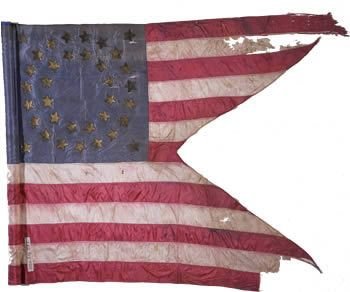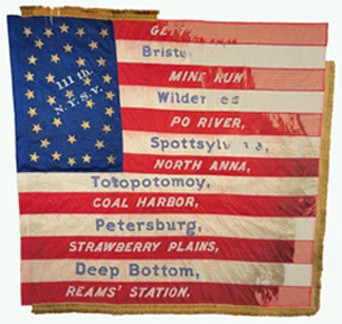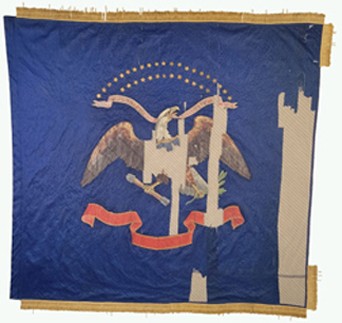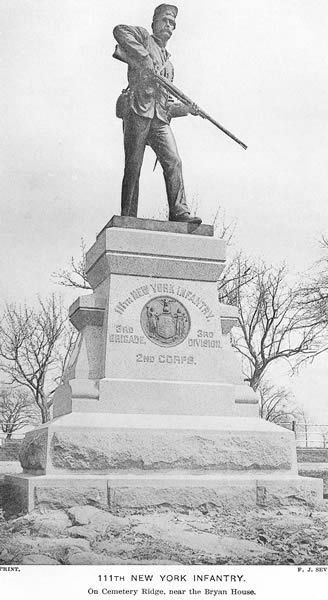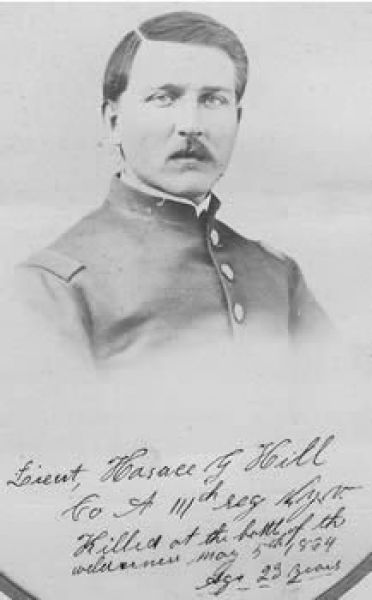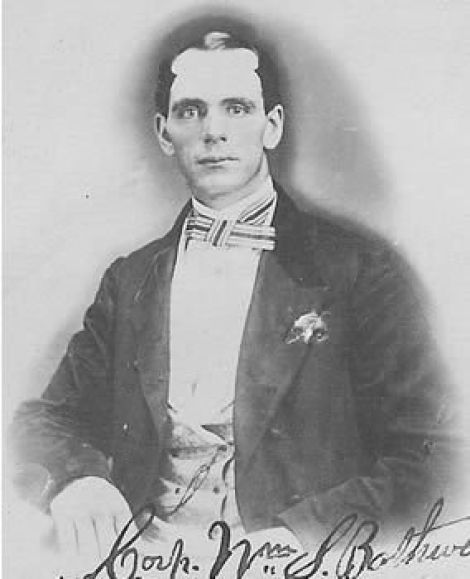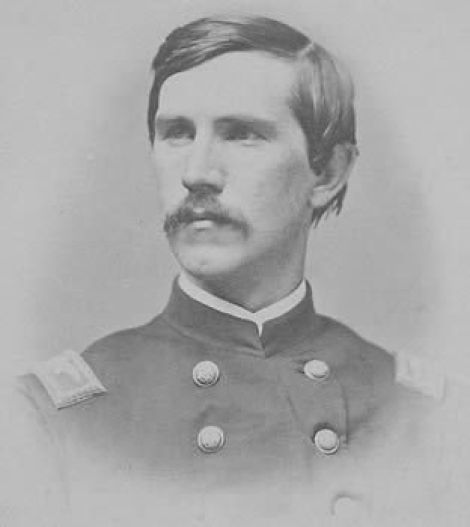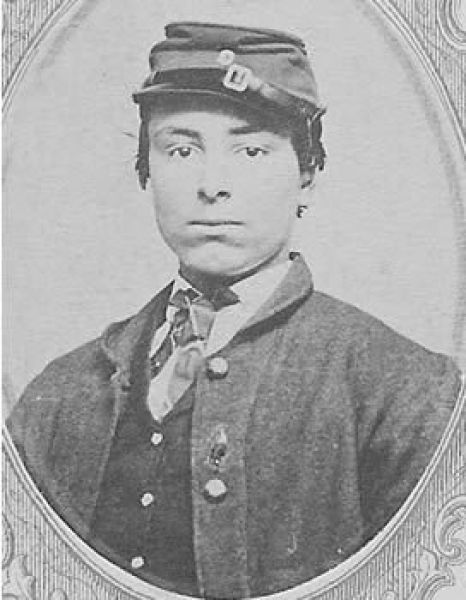Other Resources
This is meant to be a comprehensive list. If, however, you know of a resource that is not listed below, please send an email to ng.ny.nyarng.list.historians@army.mil with the name of the resource and where it is located. This can include photographs, letters, articles and other non-book materials. Also, if you have any materials in your possession that you would like to donate, the museum is always looking for items specific to New York's military heritage. Thank you.
Auburn University. Guide to the Thomas Dadswell, Papers, RG 308.
Held by the Special Collections and Archives, Auburn University Libraries.
Abstract: Inventories papers consist of 20 letters Dadswell wrote to his family from various places in Virginia. Amc archives.
Baker, John. Letter from John Baker : 111th New York Volunteer Infantry.
Benton, James D. and Christopher E. Loperfido, (editor). A Surgeon's Tale : The Civil War Letters of Surgeon James D. Benton, 111th and 98th New York Infantries, 1862-1865. Ten Roads Publishing, LLC, 2011.
Benton, James D. and Christopher E. Loperfido, (editor). Death, disease, and life at war : the Civil War letters of Surgeon James D. Benton, 111th and 98th New York Infantry Regiments, 1862-1865. El Dorado Hills, CA: Savas Beatie LLC, 2018.
Binney, Henry M. Henry M. Binney report.
Description: 1 item
Abstract: A report by Lieutenant Henry M. Binney, A.D.C. on the strength of the garrison at Harpers Ferry and on Winchester R. Road. Binney details the number of troops and armaments that are at Harpers Ferry, Va. and Maryland Heights.
Held by the US Military Academy at West Point.
Boardman, H. Lansdale. Civil War letters, 1862.
Description: 56 items
Language: English; Some of the letters are written in French.
Abstract: The collection consists of letters written by Private Boardman to his mother while he was serving in the commissary department of Company G, 22nd Regiment New York Volunteers at Fort Monore, Virginia, and at "Fort Aspinwall" (named after the regiment's commander, Lt.-Col. Lloyd Aspinwall) near Harper's Ferry, and Bolivar, Virginia. The letters describe the rountine of camp life, guard duty, picket duty, military parades and drills, the devastated condition of the town of Harpers Ferry, deserted by its inhabitants, the military diet, the feeding of the troops in the commissary tent, supplies of fresh foods received from local vendors, visitors at camp, and the arrival of 87th Ohio Volunteers, the 111th N.Y. Volunteers, and the 15th Indiana Battery. Mention is also made of the arrival of one of [Matthew] "Brady's men" who took pictures of the regiment for sale at "infernally high" prices. Included is a carte-de-visite photograph of Boardman in militrary tunic, and a contemporary press clipping captioned "Western Virginia / The Twenty-Second New York Regiment at Bolivar."
Held at the New York Public Library.
Burrud, John B. John B. Burrud papers, 1862-1870 (bulk 1862-1865).
Description: 4 boxes (5 linear feet)
Abstract: In the letters to his wife, John B. Burrud, shared his war experiences, political views, religious sentiments, and intense longing for his home and family. The letters, many written over two or three days, cover the regiment's organization in Auburn, New York in September 1862; training in New York City; the voyage to Louisiana; the 1863 campaigns in Louisiana and duty at Morgan City, Bayou Boeuf, and Pattersonville; Burrud's month-long stay in St. James Hospital in New Orleans; the Red River and the Shenandoah Valley Campaigns of 1864, including the battles of Pleasant Hill (April 9), the third Winchester (September 19), Fisher's Hill (September 22-23), and Cedar Creek (October 19); duty at Middletown and Winchester, Virginia (1864 October27-1865, April), and Washington, D.C. (1865 April-June); the Grand Review (1865 May 23-25); and duty at Savannah and Hawkinsville, Georgia (1865 June-November). In addition to the detailed accounts of the campaigns and battles and discussion of the commanding officers (Weitzel, Banks, Grant, Sheridan, and others), Burrud's letters contain descriptions of Louisiana, Virginia, Maryland, and Georgia countryside, especially historical sites (e.g. the remains of the Jamestown church; the place of John Brown's execution; Blakely, a farm near Charles Town, West Virginia that belonged to George Washington's family, museums, public building, and gardens of Washington, D.C., or a Creek Indian mounds in Pulaski County), and natural wonders and various species of wildlife. He also reports, often in elaborate detail, encounters with residents, particularly enslaved people, contrabands, and women ("Yaller Gals"), who flocked to the Union lines as well as members of freedmen's aid associations and Union sympathizers. Burrud shares his thoughts on a wide range of subjects: slavery ("most damnable man degrading, soul killing, God dishonoring Institution that ever was permitted to exist on the face of the earth"); the Union cause ("the good of Mankind and the world and the Maintenance of the best and the Only true form of Government of the face of the Earth"); the Confederate government ("Jeff Davis's Empire"); Copperheads ("Political Miscreants"), African American soldiers whom he considered superior to white soldiers from "9 month regiments" and substitutes; guerrilla warfare, and race relations. He also at length discusses personal concerns and troubles of "the Boys" in his company, including an outbreak of sexually transmitted diseases and an alarming rate of marital infidelity that seems to have affected most of soldiers' wives of Wayne County; the role of women in the war effort; news from home (including his profound disappointment in the lack of patriotism and respect for the Union uniform on the part of the people of his hometown); war and political news; recruiting and draft; home front, religious revival in Marion; etc. Burrud, a staunch Republican, avidly followed political news, especially the New York state elections of 1863 and the 1864 elections. The letters also contain news from the 111th Regiment of New York Infantry where his brother William G. Burrud and his brother-in-law, Joseph Newton served as privates. An accomplished musician, Burrud also at length discusses music and army bands. Three pocket diaries cover the years of 1863, 1864, and 1865; the entries contain accounts of campaign and battles, duties, detachments, and details; and war and political news.
Held at the The Huntington Library, Art Museum, and Botanical Gardens.
Campbell, Eric A. ' "Remember Harper's Ferry!" : The degradation, humiliation, and redemption of Col. George L Willard's Brigade - Part Two.' Gettysburg: Historical Articles of Lasting Interest. 8 (January 1993) 95-110.
Civil War Collection, 1861-1980, 1861-1865 (bulk).
Description: 0.7 cubic ft. (approximately)
Abstract: Reports and letters of Capt. Joseph L. Thomas, stationed in military district of Arkansas, 1863-1864; material on Civil War Centennial and activities of 1st New York Dragoons (Reactivated); cartes-de-visite of Civil War generals and private soldiers; reminiscences of service at Pensacola Bay and elsewhere by Rev. J.N. Brown, chaplain with 111th New York Volunteers, also manuscript regimental roster; Civil War songbooks; papers and photo of Capt. Homer O. Stafford of 75th New York Volunteers, a Negro regiment, also subscription by his men for gift to him when he retired in 1864; diary of Sylvester H. Simpson, Company D, 4th New York Heavy Artillery, 1862; pension papers of Alonzo B. Shephard; letters of Abner and Charles Supplee and others; photo album of East Bloomfield soldiers.
Held at the Victor Historical Society/Valentown Museum, 403 Valentown Square, Fishers, New York.
Contant, George W. Each bee was a bullet. Dover, Del. : Grand Army Historic Publications, 1998. 60 p. : ill. ; 21 cm.
Dardswell, Thomas. Letter, 1863 July 5.
Letter describing action at the Battle of Gettysburg, Pa., including "Pickett's Charge. 1 item (3 p.)
Located at Navarro College.
Drummond, Robert Loudon. The religious pray, the profane swear: a Civil War memoir personal reminiscences of prison life during the war of the rebellion. Aurora, CO : Davies Group, 2002. x, 108 p. : ill. ; 22 cm.
Drummond, Robert Loudon. Recollections.
Recollections of an Auburn, N.Y., lawyer of his service during the Civil War with the 111th New York Infantry Regiment, contained in an address, 1914, given at Salisbury, N.C., where he had been imprisoned; and other speeches and a letter about his war service and imprisonment.7 items.
Located at the University of North Carolina, Chapel Hill.
Eldred, N. Only a boy : a first-hand account of the Civil War. Cato, N.Y. : [publisher not identified], 1909
Held at the Onondaga County Public Library.
"Every man dropped I pointed at." Neighbor’s Home Mail. 1879. 135.
Failing, Charles M. Civil War Miscellaneous Collection
(Pvt's service hist, discharge paper & letter from U.S. Grant, 1862-1902)
Located at the Military History Institute in Carlisle, PA.
"Fording the Rapidan." : and Watching for Mosby." Neighbor’s Home Mail. January and February 1877. 53.
Fox, William F. and Daniel E. Sickles. New York (State). Monuments Commission for the Battlefields of Gettysburg and Chattanooga. "Oration of Gen. Clinton D. MacDougall." Final report on the battlefield of Gettysburg. Albany: J.B. Lyon Co., printers, 1902. 799-805.
Gero, Anthony F., Boots : a novella of the Civil War. Iowa City, IA : Camp Pope, 2013.
Hall, Henry. History of Auburn. Auburn, NY: Dennis Brothers & Co., 1869. pp. 429-435.
In vertical file.
Hinman, Wellington. Diary of Mr. Wellington Hinman of Summer Hill, Cayuga County, New York, Private of Co. C 111th N.Y. Vols. Unpublished.
Original in Cortland County Historcal Society.
Holcomb, Edward. Diary, 1863.
Diary contains details of this common soldier's life, January 1-December 31, 1863. 1 item.
Located at Auburn University.
Hudson, Joel H. "Extracts from the Journal of Joel H. Hudson." Neighbor's Home Mail.
Husk, Martin W. The 111th New York Volunteer Infantry: a Civil War history. Jefferson, N.C. : McFarland & Co., 2010.
Hutchins, Daniel B. Daniel B. Hutchins journals, 1864 - 1866.
2 volumes.
Abstract: Daniel B. Hutchins was raised in Wayne County, N.Y., and worked as a school teacher prior to the outbreak of the Civil War. In 1864, Hutchins was enrolled as a sergeant in the 111th New York Infantry, serving in eastern Virginia. In two pocket diaries, covering the years 1864 and 1866, Hutchins recorded his singularly awful experiences as he was transported through a succession of Confederate prison camps, including Libby, Andersonville, Charleston, S.C., and Florence.
Located at the William L. Clements Library, University of Michigan.
Thank you to Jason Longo for pointing out this resource.
Kelland, John B. L., Letters from John B.L. Kelland of the 111th Regiment of the New York Volunteers to members of his family, 1862-1877.
Description: 27 items
Abstract: Most of the letters are written from various places in Virginia; a few date after the war and describe the silk and fur hat industry in Pittsburgh, Pennsylvania.
Held at the University of Virginia.
Laekner, Simeon. Correspondence, 1863-1864.
Letters addressed to Simeon Laekner of Puttneyville, Wayne County, New York from friends or relatives serving in the Union Army during the Civil War. They were written in Dutch, which presents a problem in verifying information and names with the official records. One of the items was written by Lieut. Andrew Camp, 111th Infantry, Company D, informing that David Laekner, a son, was wounded and in a Washington D.C. hospital. Letters seem to discuss how the unnamed company went from Albany to Washington, and then to camp near Culpeper, Virginia. 3 items.
Located at the New York State Library Manuscripts and Special Collections.
Lightfoote, W. G. Proceedings of the reunion of the veterans of the 111th and the 126th reg'ts N.Y. Canadaigua, N.Y.:Times Book and Job Print. House, 1886. 38 p.
MacDougall, Clinton Dugal. General Clinton Dugald MacDougall papers, 1864-1913.
Description: 1 Box (1 Box, 12 folders)
Abstract: The collection contains holograph letters written to and by MacDougall. Letters are primarily personal in nature. Many letters are written by MacDougall to his wife, Eva Sabine MacDougall, as well as from miscellaneous friends, family members, and associates. Collection also contains miscellaneous documents produced by and related to MacDougall, including a handwritten address (perhaps by MacDougall) intended for an audience of some kind, photographs of MacDougall, as well as various calling cards, newspaper clippings, and notices.
Held at Middlebury College.
MacDougall, Clinton Dugal. Letters.
Held at Hamilton College.
Monroe, Joel H. "Gen. Clinton D. MacDougall." Historical Records of a Hundred and Twenty Years. Geneva, NY: W.F. Humphrey, 1913.
In vertical file.
Murray, R.L. and David Hickey (ed.). The redemption of the "Harper's Ferry Cowards" : the story of the 111th and 126th New York state volunteer regiments at Gettysburg. 1994. [E 523.5 126th .M].
Murray, R. L. Cayuga County troops in the Civil War. Wolcott, N.Y. : Benedum Books, 2003.
New York Assembly. Proceedings of the Assembly of the State of New York, in relation to the death of James Haggerty, held at Capitol, January 20, 1888. Troy: Troy press co., 1888.
New York (State). Monuments Commission for the Battlefields of Gettysburg and Chattanooga. "Oration of Gen. Clinton D. MacDougall." Final report on the battlefield of Gettysburg. Albany: J.B. Lyon Co., printers, 1902. 799-805.
Parks, Edwin A. Parks letters
Abstract: Letters from Edwin A Parks (1843-2 May 1863) to his family: Frederick S Parks, Nancy Goldthrite Parks, Elizabeth (Libbie, Lib) Parks, Sylvester (Vet) Parks, Sarah E Parks, Effie May (Effa) Parks, Electra H Parks. He served in the New York State Volunteers, 111th Regiment.
Orignals held at the Geneva Historical Society.
Parks, James Madison. James Madison Parks papers. 1856-1867.
Diary describing his Civil War experiences; also correspondence of Parks and his wife, Laura Gorsline Parks. 1 folder.
Located at Bentley Historical Library, University of Michigan.
Paylor, John. Civil War Diary - 1862. Unpublished.
Transcript furnished by Donald Chatfield.
"Partial history of the 138th New York." : Better known as the Ninth New York Heavy Artillery." Neighbor’s Home Mail. 1879. 103.
Scott, Adonijah C. Adonijah C Scott Correspondence.
Originals held by the Geneva Historical Society.
Segoine, Jesse, et al. Letters to Jesse Segoine, 1860-1870.
Description: 3 items.
Abstract: Two letters to Segoine, one from C.A. Seward in Geneva, New York (August 7, 1860), the other from F.W. Seward at Montrose, New York (August 25, 1870). In the first letter, C.A. Seward encourages Segoine to rejoin the military, and discusses what can be done to secure an officer's appointment for him. In the second letter (housed with its envelope), F.W. Seward promises to help Segoine the next time he is in New York.
Held at Cornell University.
Sentell family. Diaries and letters, 1856-1897.
Diaries (December, 1862-October, 1864) of Edward H. Sentell and letters (1856-1897) of various family members. Diaries include detailed entries by Edward Sentell while serving as Lieutenant in the 160th N.Y.S.V. He describes his voyage to Fort Jefferson, Florida and New Orleans, activities on the Red River in Louisiana, his voyage on the steamer Leary to Virginia in July, 1864, and his stay in Maryland and Virginia until October, 1864 when the entries stop. One box of letters are mostly Civil War letters of William H. Sentell while a sergeant in the 44th N.Y.S.V. in Virginia and as major in the 160th in Louisiana; and Charles Sentell, a soldier in the 111th N.Y.S.V. in Virginia. The postwar letters concern such matters as farming, relatives in Wisconsin, private affairs, etc. 4 v. 97 items.
Located at the New York Historical Society, New York, NY.
Six colored views : Camps of New York regiments during the Civil War.
[6] leaves of plates : chiefly col. ill. ; 27 x 37 cm.
Contents: Fort Ethan Allen, Garrisoned by the 4th N.Y. Heavy Artillery. Col. D. Doubleday, Commdg. -- Camp Pomroy, 111th Regiment, New York. Col. J. Segoine, Commdg.-- Camp Chase, 147th Regt. N.Y.S.V. Col. A.S. Warner, Commdg. -- Fort Pennsylvania, Head Quarters of the 113th Regt. N.Y.S.V. Col. O.L. Morricee, Commdg. -- Camp Seward, 170th N.Y.V. 2d Regiment, Corcoran's Legion, Col. Peter McDermott, Lieut. Col. J.P. McIvor -- Camp Hathaway, 141st Regt. N.Y.S.V.S.G. Hathaway, Col. Commanding.
Located at the Massachusetts Historical Society.
Thompson, Benjamin W. "Narrative of Experiences of Civil War." Civil War Times Illustrated Collection.
Original located at Military Heritage Institute, Carlisle, PA.
Thompson, Benjamin W. "This Hell of Destruction." : The Benjamin W. Thompson Memoir - Part 2." Civil War Times Illustrated. 12 :5 October, 1973. 13-24.
Thompson, Benjamin W. "Back to the South." : The Benjamin W. Thompson Memoir - Part 3." Civil War Times Illustrated. 12 :5 October, 1973. 28-39.
Thompson, Benjamin W. "A President's Jailor." : The Benjamin W. Thompson Memoir - Part 4." Civil War Times Illustrated. 12 :5 October, 1973. 24-33.
Thompson, Benjamin W. Narrative of Experiences of Civil War.
Thompson, Samuel. Miscellaneous Civil War letters and records from Oswego, Cayuga, and Oneida counties, New York. 1861-1865.
The collection consists of miscellaneous letters, diaries, and records written by residents of Oswego, Cayuga, and Oneida counties, who partook in the Union effort to put down the rebellion in the South. Descriptions of military life and Civil War battles are included in the collection.
1 folder (16 items).
Located at State University of New York at Oswego.
United States. Army. 111th New York Infantry records,1862-1865.
Records consisting mainly of muster rolls, with a few other miscellaneous papers, including allotments of pay with related correspondence, a power of attorney, receipts, and bills for hospital dues.
0.8 linear feet (2 boxes).
Located at the New York Historical Society, New York, NY.
United States. Army. New York Infantry Regiment, 111th (1862-1865). Roster of survivors of the 111th Reg't N.Y.S. Vol's. September, 1903. 15 p. ; 16 cm.
Located at the National Archives.
Items in the museum collection are in bold.
